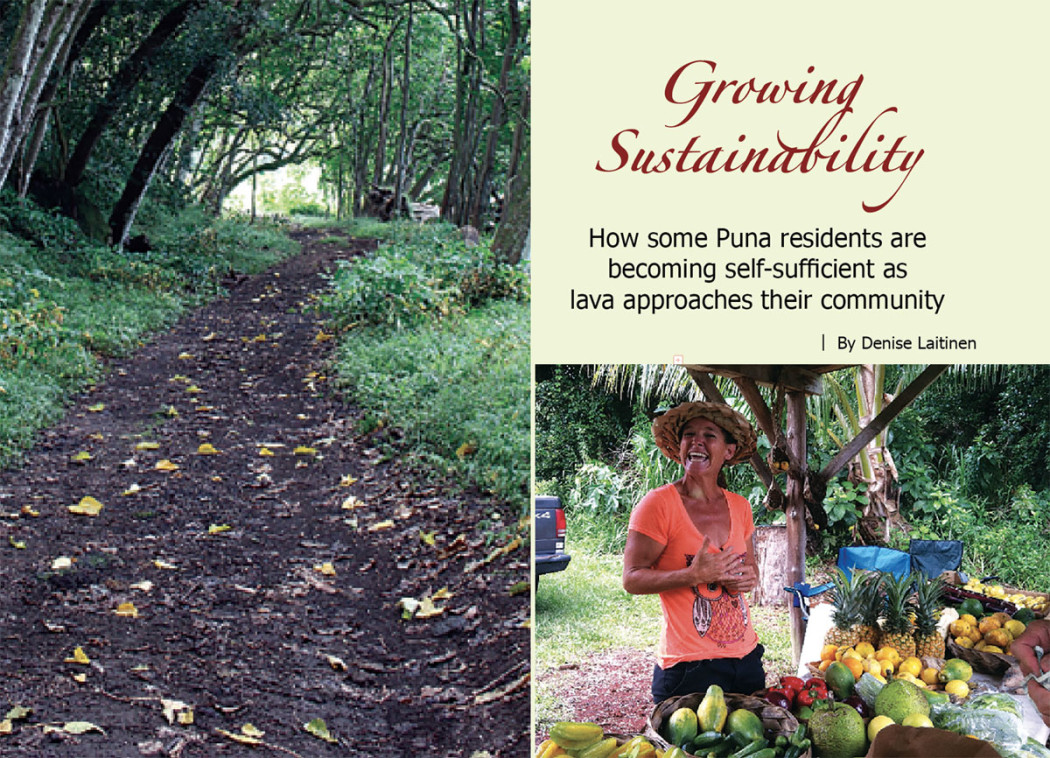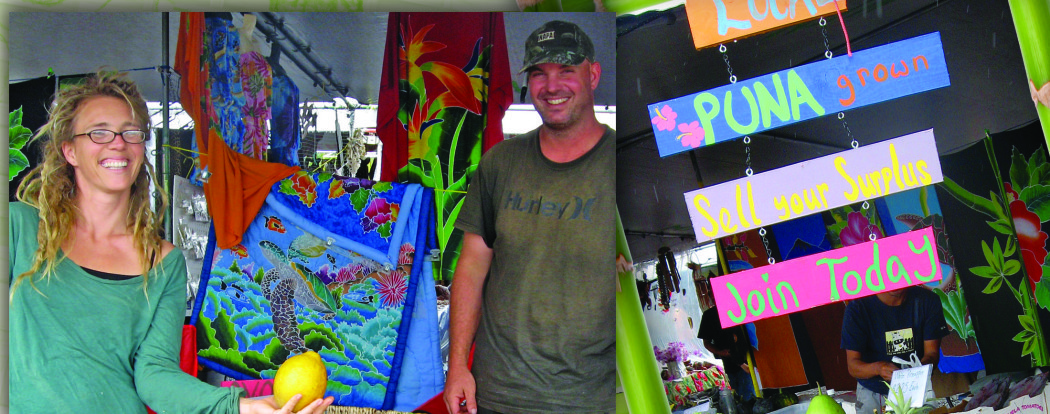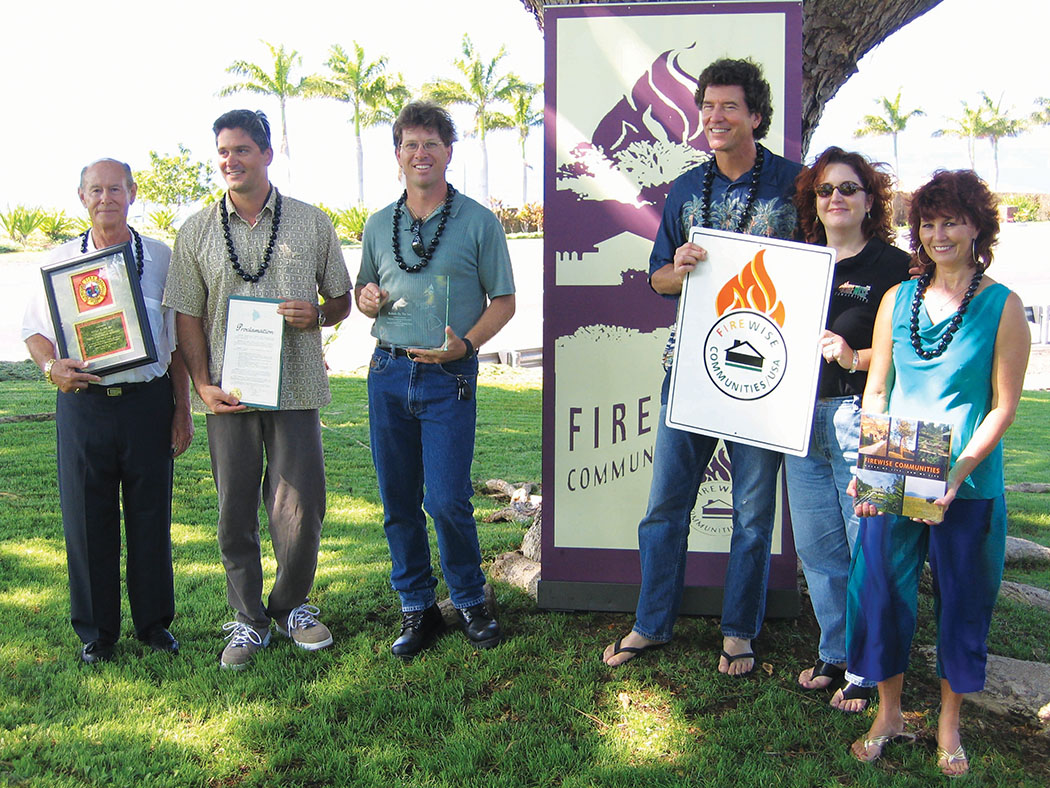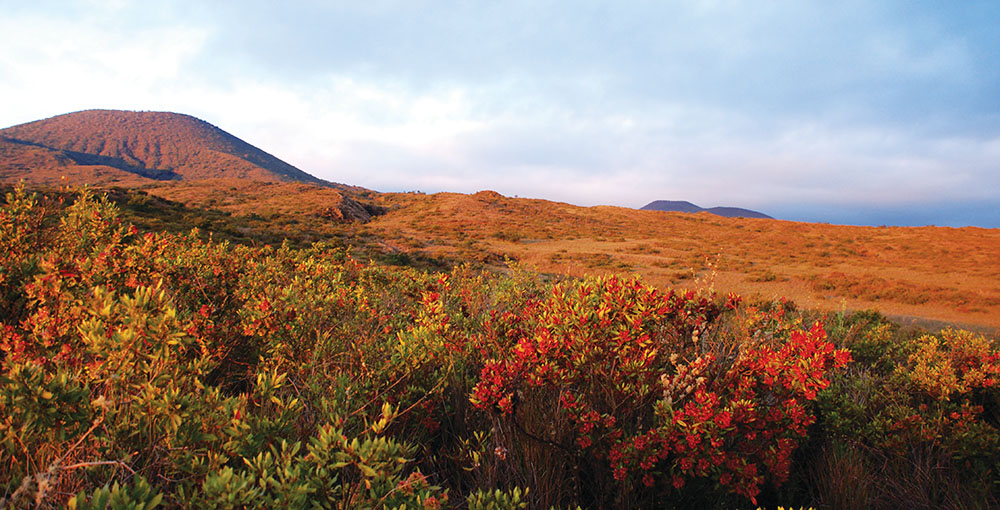
Saving Hawai‘i’s Native Dryland Forests

By Denise Laitinen
Every day, hundreds of Hawai‘i Island residents and visitors drive past them—most having no idea about the rare treasures they are zipping past as they travel along Māmalahoa Highway between Waimea and Kailua-Kona.
These incredible treasures are so rare that 90 to 95 percent of their kind have already been destroyed on Hawai‘i Island alone, never to be seen again.
I’m referring to Hawai‘i’s dryland forests, unique ecosystems found on the leeward side of the island from sea level to mid-level elevations, as well as areas of Puna, Ka‘ū, and the slopes of Mauna Kea.
Receiving less than 50 inches of rain a year, dryland forests are remarkably diverse ecosystems featuring more than three-dozen native plant species. In fact, more than 25 percent of Hawai‘i’s endangered native plants are found in these forests. They’re also home to rare and endangered birds such as the ‘amakihi and palila, as well as insects like the ‘ōka‘i, the Munduca blackburn-sphinx night moth.
In his 1913 book, The Indigenous Trees of the Hawaiian Islands, botanist Joseph Rock singled out the dryland forests of Hawai‘i Island, particularly those of Ka‘ūpūlehu, adjoining Pu‘u Wa‘awa‘a, as “the richest in species as far as tree growth.” Talking about dryland forests across Hawai‘i, Rock says, “It is in these peculiar regions that the botanical collector will find more in one day’s collecting, than in a week or two in a wet region.”
Fast-forward 100 years to development, wildfires, grazing, and invasive species that have all but wiped out our island’s dryland forests, with only five to 10 percent remaining in scattered remnants that struggle to survive.
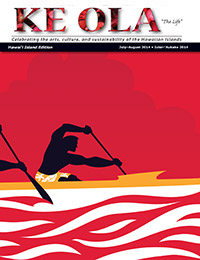
The forests and the endangered plants, trees, birds, and insects found within them have a staunch ally in the myriad assortment of individuals, groups, and agencies that strive to save them. One such group focused on preserving these rare native forests is the nonprofit Ka‘ahahui ‘O Ka Nāhelehele, commonly shortened to Nāhelehele.
Nāhelehele grew out of the Dryland Forest Working Group, an informal group that came together in the 1990s to try and preserve what was left of the dryland forests in Hawai‘i.
The group was comprised of a broad mixture of concerned citizens, businesses, developers, agencies, and others, including Hawai‘i Forest Industry Association, (HFIA), Kamehameha Schools Bishop Estate, Hannah Kihalani Springer, Lisa Hadway, State Department of Land and Natural Resources, US Forest Service, Keoki and Yvonne Carter, Sally Rice, and many others. Coming from different industries and perspectives, the group was united in their passion to protect Hawai‘i’s dryland forests.
Sally Rice, owner of Agro Resources Inc. and current president of Nāhelehele’s board of directors, recalls those early days. At the time, the group was focused on saving the dryland forest in Pu‘u Wa‘awa‘a, an area grazed by various cattle ranches under a crown lease for nearly a century. In 2000, the last cattle lease expired.
“What happened was the Pu‘u Wa‘awa‘a lease was up, and there was a group of very concerned people who recognized that Pu‘u Wa‘awa‘a is a unique and marvelous ecosystem and pretty much all dryland forest.
“Hannah Springer, Chris Yuen, Randy and Peter Vitousek, myself and several others got together to apply for the lease from the State Department of Land and Natural Resources.”
The Board of Land and Natural Resources turned down the group and the lease was ultimately given to the State Division of Forestry and Wildlife.
The Dryland Forest Working Group persevered. They decided to focus their energies on a demonstration site that could show that a dryland forest could be preserved while serving as an inspiration to others.
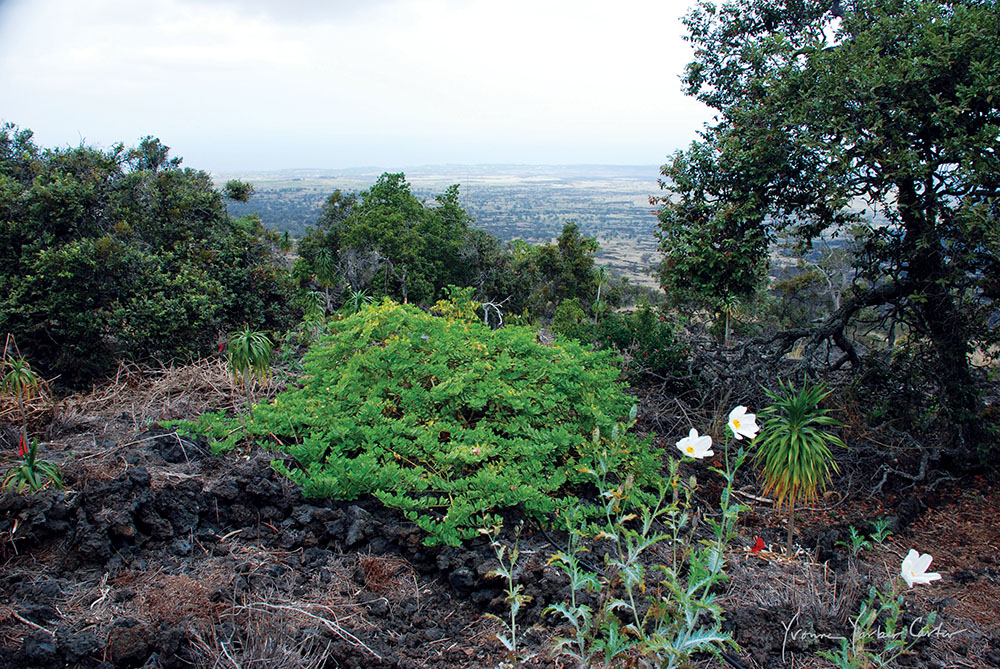
With the Dryland Forest Working Group guiding the way, a formal agreement was signed between the US Fish and Wildlife Service and the Hawaii Forest Industry Association to conserve a native dryland forest in North Kona at Ka‘ūpūlehu.
A few years later the State Division of Forestry and Wildlife was working with the US Forest Service Institute of Pacific Islands Forestry to establish two protected forest reserves on-island, one in Laupāhoehoe and one in Pu‘u Wa‘awa‘a.
Managed as a State Forest Reserve, the Pu‘u Wa‘awa‘a Experimental Forest in North Kona covers 38,885 acres on the northern flank of Hualālai volcano, extending from sea level to within one mile of the mountain summit.
The 76-acre Ka‘ūpūlehu forest preserve is located within Kamehameha Schools land and managed with collaborators.
“HFIA was the organization that supported grant monies that came through in the very early days,” says Yvonne Yarber Carter, part-time outreach education and volunteer coordinator, at the Ka‘ūpūlehu dryland forest.
Part scientific research project, part restoration project, with a myriad of organizations working in partnership, the Ka‘ūpūlehu forest is a place where people can learn about these rare forests while working to protect them.
Initially, the Dryland Forest Working Group kept a low profile, not wanting to attract attention to the demonstration site or dryland forests in general for fear that they might be overrun with visitors who could potentially harm the very ecosystem they were trying so hard to restore.
In 2002, Yvonne says the group made a fundamental shift to conduct more outreach.
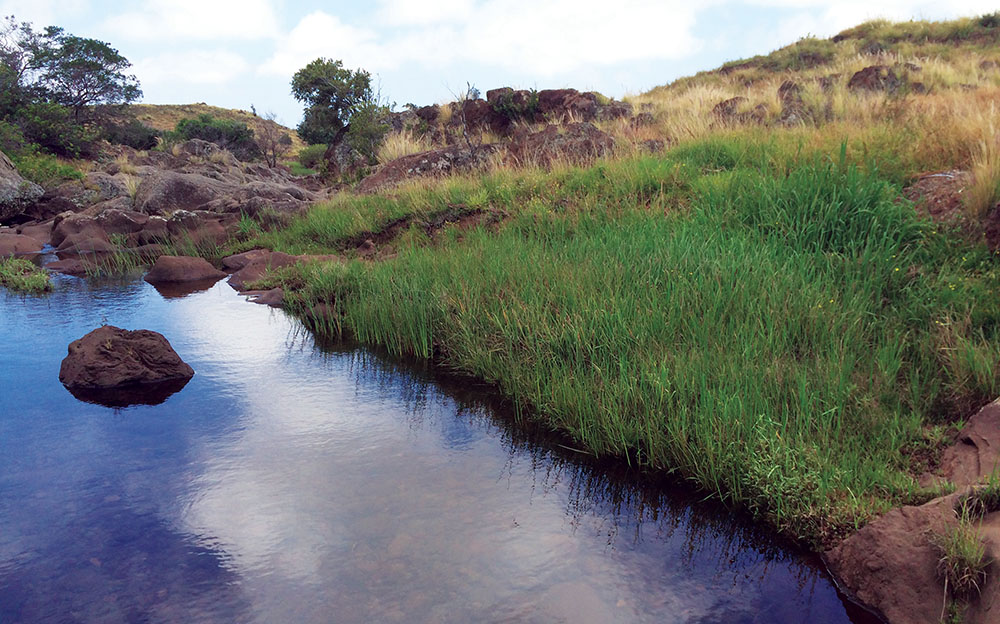
The group changed perspectives and realized that “if people know about [the dryland forest] they can care about it. That’s when I was hired as the part-time outreach person in 2002,” Yvonne explains.
Yvonne spent the first four years on the job working on strategic planning, organizing meetings, and building partnerships between all the groups involved.
At the same time, the Dryland Forest Working Group was also evolving. With the creation of the Ka‘ūpūlehu demonstration site, which was being managed by HFIA, Sally says the group decided to expand their focus and mission.
“Heather Cole, Hannah Springer, Randy Vitousek, and I got together and decided to expand the mission to include dryland forests throughout the state,” says Sally.
As part of that evolution, the group decided to become a 501c(3), with a formal board of directors.
“We asked Hannah Springer to name our organization, and that’s how Ka‘ahahui ‘O Ka Nāhelehele came to be in 2005,” explains Sally.
“Our mission is to advocate for the perpetuation of Hawai‘i’s dryland forests and the endangered birds and plants and insects within these communities.
”We look for a need within the dryland forest arena and look to see how we can be of help to either get the project started or fill a need.”
Their work is all the more remarkable given that Nāhelehele does not have a paid staff.
Sally points out that members of Nāhelehele’s board, “wear several different hats so the networking and communication is very good among the people involved in dryland forest restoration.”
One of those long-term projects is an annual symposium that Nāhelehele coordinates. Since 2007, Nāhelehele has held the dryland forest symposium in Kailua-Kona every February bringing together researchers and conservationists from around Hawai‘i and the US mainland to share ideas about protecting Hawai‘i’s dryland forests.
Kathy Frost, vice president of Nāhelehele’s board of directors spearheads the symposium. “It’s her baby,” says Sally. “She’s done a fantastic job and it’s become a popular educational forum.”
Another key education project for Nāhelehele was the creation of an information-rich website resource about Hawai‘i’s dryland forests.
The comprehensive website, which was designed by Yvonne and her husband Keoki Carter, features a resource guide for grades three through eight, downloadable curriculum information for teachers, as well as detailed information on dryland forests, the various organizations working to protect them, and information on the annual dryland forest symposium.
Yvonne developed the website for Nāhelehele in addition to her duties as outreach coordinator for Ka‘ūpūlehu.
“The website was a labor of love,” says Yvonne. “It comes from this profound commitment to protecting the dryland forest.”
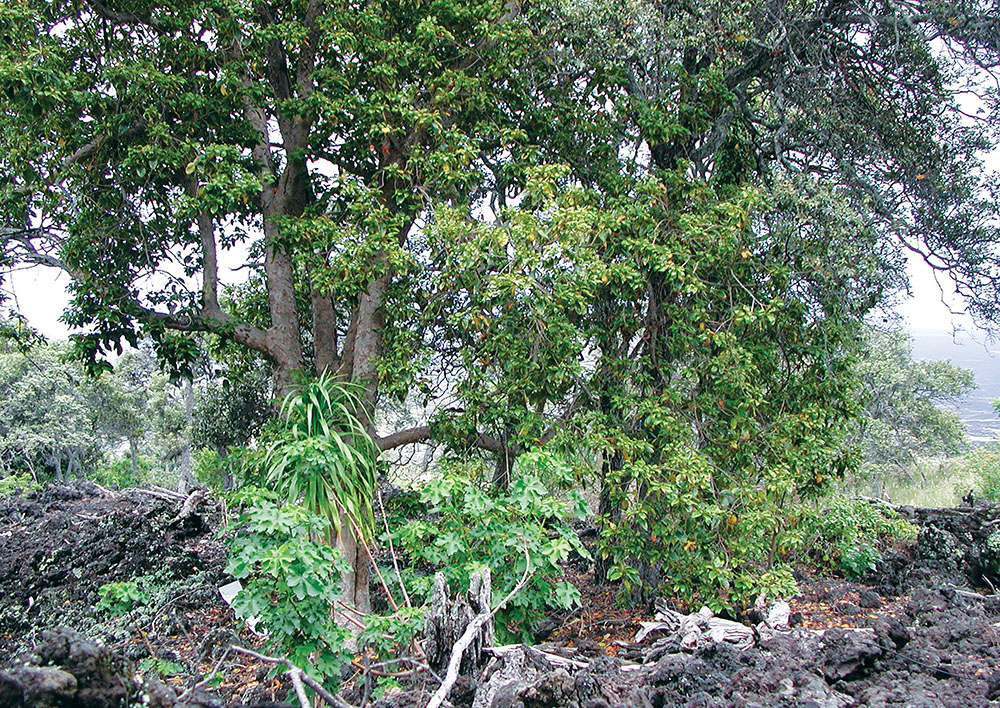
Today, restoration work still continues at the Ka‘ūpūlehu forest. HFIA manages the project with site manager Wilds Brawner, as well as the education program Ho‘ola Ka Makana‘ā at Ka‘ūpūlehu, (“healing the place budding up out of the lava”), an on-site collaborative volunteer outreach program.
With several capable organizations protecting the dryland forest in Pu‘u Wa‘awa‘a, Sally says that Nāhelehele’s immediate focus is a park project in Waimea. Located on the Mauna Kea side of Kawaihae Road, the park was given to the County by Henry Clark.
Sally notes that the Waimea project differs from work they’ve done in Pu‘u Wa‘aWa‘a.
“It’s a little different from what we were doing, as the Ouli Park has a stream that runs through it. We’ll be doing riparian work using native plants to prevent erosion along the stream. We also got a $10,000 urban beautification grant to put in irrigation at the park,” says Sally.
She points out that by restoring the dryland forest in this Waimea community, the project can be a model to be used by other groups doing similar projects either on-island or across the state.
It is the multitude of people and organizations working together to save the critically endangered forests that gives Sally the most hope.
“There are a multitude of people who realize how important the dryland forest is and have stepped up to do something about it. They are walking the walk, not just talking about it,” says Sally.
“Back in 2000, no one could have imagined the projects we are doing,” adds Yvonne, in regard to the work being done at Ka‘ūpūlehu. “It all stemmed from a group of people that never gave up hope.” ❖
To learn more about the Ka‘ūpūlehu forest and Hawai‘i’s other dryland forests: DrylandForest.org
To link to digital mural learning activities go to Lesson 6: DrylandForest.org/learn-more-here
Contact Yvonne Yarber Carter: yyc@trylookinside.com
Contact writer Denise Laitinen: Denise@deniselaitinen.com
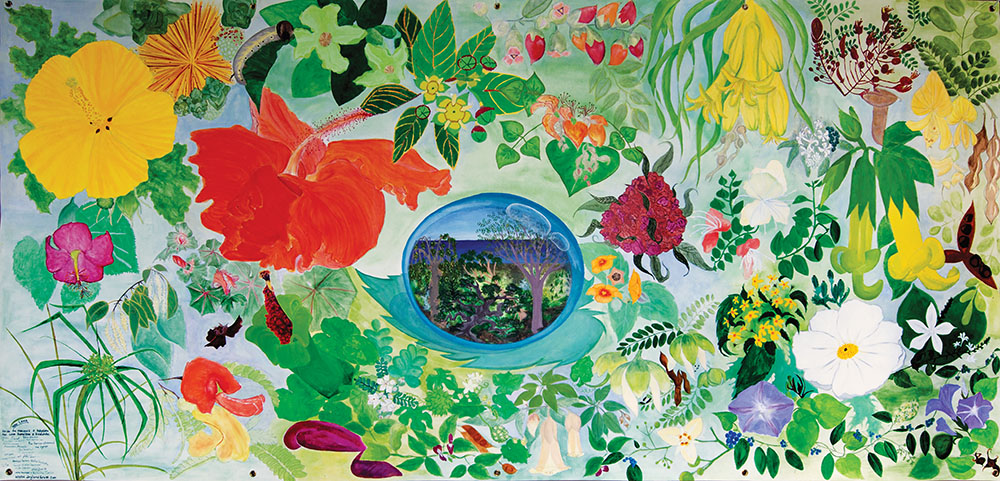
The mural used in this learning resource began with an invitation to participate in a statewide event to paint 16-murals celebrating the land and the United Nationʻs “International Year of the Forest” from the mountain to the sea.
As part of the Ka‘ūpūlehu dryland forest project, Ho‘ola Ka Makana‘ā agreed to paint a mural representing the dryland forest, and in turn invited partners from Ka‘ūpūlehu mauka to makai, and La‘i‘Ōpua at Kealakehe to hui (gather together) to express through art, their aloha and dedication to the legacy of these rare natives.
The mural hui included 23 painters from age 7 to 60.
If you are interested, a variety of Ka‘ūpūlehu dryland forest education opportunities are available through their ‘Āina Ulu-Kamehameha Schools program. Resources include displays, presentations, classroom or community group visits, special events, and structured “work while learning” visits. Learn more by contacting Yvonne Yarber Carter.
Yvonne says there are limited volunteer work days open each year, and advanced scheduling is required. The work done by visiting groups depends on what the forest needs at the time. Activities are matched to the group.
The range of projects varies says Yvonne. “It might be making trails or pulling weeds, collecting data or planting plants.”
With its steep and rough terrain, however, not everyone can travel to the Ka‘ūpūlehu forest. In those situations, Yvonne says they bring the information to the group, be it a school or other organization.
